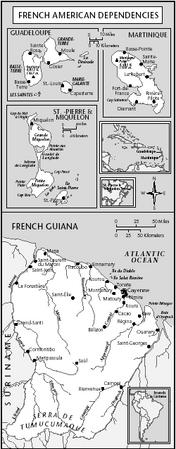French American Dependencies - St. pierre and miquelon
The French territorial collectivity of St. Pierre and Miquelon (Territoire des Îles Saint-Pierre et Miquelon) is an archipelago in the North Atlantic Ocean, between 46° 45′ and 47° 10′ N and 56° 5′ and 56° 25′ W , located about 24 km (15 mi) W of Burin Peninsula on the south coast of Newfoundland. It consists of

three main islands, St. Pierre, Miquelon, and Langlade—the two latter linked by a low, sandy isthmus—and several small ones. The length of the group is 43 km (27 mi) N–S , and it measures 22 km (14 mi) E–W at its widest extent. The total area is 242 sq km (93 sq mi). The islands were the focus of a maritime boundary dispute between Canada and France, but in 1992 an arbitration panel awarded the islands an exclusive economic zone area of 12,348 sq km (4,768 sq mi) as a settlement. Although the archipelago is volcanic in origin, the highest point, Morne de la Grande Montagne, is only 393 m (1,289 ft). The temperature varies between an average daily low of–15° C (5° F ) in winter and an average daily high of 22° C (72° F ) in summer. The spring and autumn are very windy, and fogs are frequent throughout the year; annual precipitation averages 130 cm (51 in). Vegetation is scanty, except on Langlade, where several species of trees are found. Animal life includes seabirds, foxes, rabbits, and deer. The population in mid-2002 was estimated to be 6,954. Most of the people are descendants of Basque, Breton, and Norman settlers and are Roman Catholics.
The first permanent French settlement dates from 1604, and, except for several periods of British rule, the islands have remained French ever since. They became a French overseas territory in 1946, an overseas department in 1976, and a territorial collectivity in 1985. The economy has traditionally centered around fishing and by servicing the fishing fleets operating off the coast of Newfoundland, but the number of ships stopping at St. Pierre has been declining in recent years. Also affecting the economy are disputes with Canada over fishing quotas. The islands receive significant subsidies from France. Total exports in 1999 amounted to US $12 million, while imports totaled US $55 million, requiring heavy subsidies from France.
Comment about this article, ask questions, or add new information about this topic: